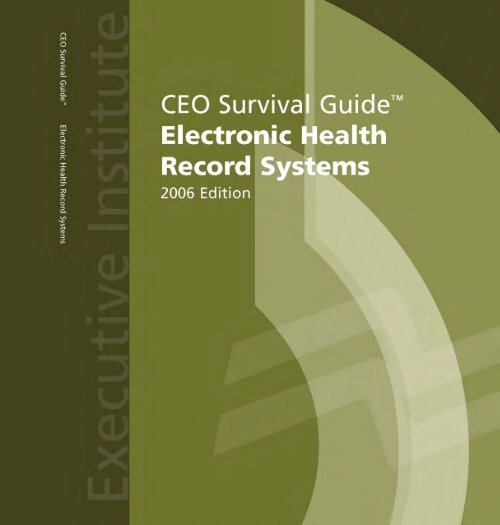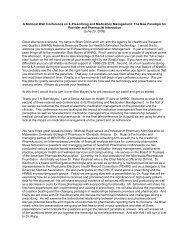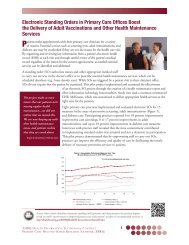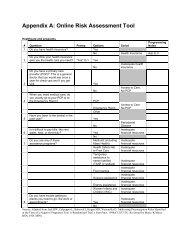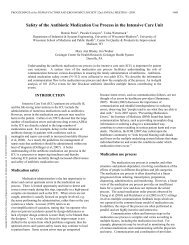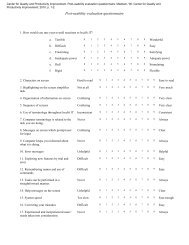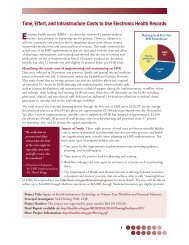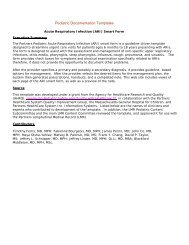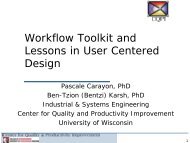CEO Survival Guide - AHRQ National Resource Center; Health ...
CEO Survival Guide - AHRQ National Resource Center; Health ...
CEO Survival Guide - AHRQ National Resource Center; Health ...
You also want an ePaper? Increase the reach of your titles
YUMPU automatically turns print PDFs into web optimized ePapers that Google loves.
© 2006 by the <strong>National</strong> Quality Forum All rights reservedISBN 1-933875-04-6Printed in the U.S.A.No part of this may be reproduced, stored in a retrieval system, or transmitted, in any form or by anymeans electronic, mechanical, photocopying, recording, or otherwise, without prior written permission ofthe <strong>National</strong> Quality Forum. Requests for permission to reprint or make copies should be directed to:Permissions<strong>National</strong> Quality Forum601 Thirteenth Street, NW, Suite 500 NorthWashington, DC 20005Fax 202.783.3434www.qualityforum.org
Terms of Reference P 5 of 7Feasibility: Conference, Performing Arts and Visual Arts, and Tourist Services Centre Feasibility StudyPHASE III• Facility analysis• Economic analysis• Ten-year projections;• Estimated pro-forma statements; and• Analysis of community economic benefit.• Conceptual design analysis, proposing size ranges and linkages of core and supportareas including public spaces, administrative spaces, mechanical and support spacesand other necessary spaces required to meet the needs articulated in both Phase I andPhase II;• Identification of those areas, if any, where a three-function facility accomplisheseconomies in either capital or operating costs and quantification of those economies;• Identification and preliminary evaluation of potential development sites.• Estimated facility capital cost, excluding cost of land and servicing, and includingallowances for furniture, equipment in the conference and arts spaces only, withallowances for environmentally sustainable design and materials considerations;• Five-year estimated operational revenues and revenue sources;• Five-year estimated operational expenses, including recapitalization contributions;• Ten-year projections;• Estimated pro-forma statements; and• Analysis of community economic benefit.DELIVERABLESDeliverables shall include:• Final report, including:• Phase I analysis;• Phase II analysis;• Phase III analysis; and• Conclusions and recommendations;
NQF Executive InstituteElectronic <strong>Health</strong> Record Systems Task ForceCo-ChairJeffrey H. HillebrandChief Operating OfficerEvanston Northwestern <strong>Health</strong>careCo-ChairLouise Liang, MDSenior Vice PresidentQuality and Clinical Systems SupportKaiser Foundation <strong>Health</strong> Plan, Inc.Task Force MembersJohn BardisChairman, President & <strong>CEO</strong>MedAssetsMolly Joel Coye, MD, MPHPresident and <strong>CEO</strong>The <strong>Health</strong> Technology <strong>Center</strong>Kelly CroninDirectorOffice of Programs and CoordinationOffice of the <strong>National</strong> Coordinator for<strong>Health</strong> Information TechnologyDon Detmer, MDPresident & <strong>CEO</strong>American Medical Informatics AssociationWilliam M. DwyerSenior Vice PresidentCerner CorporationKent GalePresidentKLAS EnterprisesBrent James, MD, M.StatExecutive DirectorInstitute for <strong>Health</strong> Care DeliveryIntermountain <strong>Health</strong> CareThomas LeeNetwork PresidentPartners <strong>Health</strong>Care SystemSteven B. Pierdon, MD, MMMAssociate Chief Medical Officer,Clinical OperationsGeisinger <strong>Health</strong> SystemCurt M. SelquistCompany Group Chairman andWorldwide Franchise ChairmanJohnson & Johnson6 NQF Executive Institute www.NQFExecutiveInstitute.org
<strong>National</strong> Quality Forum Executive Institute StaffJanet Corrigan, PhD, MBAPresident & <strong>CEO</strong>Shari EricksonSenior Program DirectorLauren MurrayResearch AssociateStephanie PedittoConsultantJohns Hopkins MedicineAcknowledgmentsNQF gratefully acknowledges Shelli Williamson and the Scottsdale Institute for coordinating areview of this document. Specifically, NQF thanks the following experienced health informationtechnology thought leaders:George Brenckle, PhDUniversity of Pennsylvania <strong>Health</strong> SystemRobert Murphy, MDMemorial HermannJeffrey Rose, MDAscension <strong>Health</strong>Steven Schlossberg, MD, MBASentara <strong>Health</strong>careJoel Shoolin, DOAdvocate <strong>Health</strong> CareFerdinand Velasco, MDTexas <strong>Health</strong> <strong>Resource</strong>swww.NQFExecutiveInstitute.org NQF Executive Institute 7
Table of ContentsExecutive Summary . . . . . . . . . . . . . . . . . . . . . . . . . . . . . . . . . . . . . . . . . . . . . . . . . . . . 11Tools for Executives . . . . . . . . . . . . . . . . . . . . . . . . . . . . . . . . . . . . . . . . . . . . . . . . . . . 13Q&A . . . . . . . . . . . . . . . . . . . . . . . . . . . . . . . . . . . . . . . . . . . . . . . . . . . . . . . . . . . 15PowerPoint presentation with speaking points . . . . . . . . . . . . . . . . . . . . . . . . 19Checklist . . . . . . . . . . . . . . . . . . . . . . . . . . . . . . . . . . . . . . . . . . . . . . . . . . . . . . . . 29Electronic <strong>Health</strong> Record Systems . . . . . . . . . . . . . . . . . . . . . . . . . . . . . . . . . . . . . . . . 33The EHR Environment Right Now . . . . . . . . . . . . . . . . . . . . . . . . . . . . . . . . . . . . . . . . 39The Provider “Value Equation” for EHRs . . . . . . . . . . . . . . . . . . . . . . . . . . . . . . . . . . 43Efforts to Speed HIT Adoption . . . . . . . . . . . . . . . . . . . . . . . . . . . . . . . . . . . . . . . . . . 47Role of <strong>Health</strong>care Executives in EHR System Implementation . . . . . . . . . . . . . . . . 51References . . . . . . . . . . . . . . . . . . . . . . . . . . . . . . . . . . . . . . . . . . . . . . . . . . . . . . . . . . . 59www.NQFExecutiveInstitute.orgNQF Executive Institute 9
Executive SummaryElectronic health record (EHR) systems arean enabling foundation for healthcare—and organizational—reform. Investment inEHR systems makes possible significant,demonstrable improvements in efficiencyand productivity. Their potential to improvethe safety and effectiveness of healthcarecreates substantial—though more difficult toquantify—value. The benefit of investmentin EHR systems will only be fully realizedif these systems are interoperable—able toexchange data across providers, sites, andorganizations. The adoption of EHR systemsby healthcare providers would save anestimated $70 billion or more annually.Many efforts are underway in both thepublic and private sector to accelerate theadoption of EHR systems. The <strong>Health</strong> andHuman Services’ Office of the <strong>National</strong>Coordinator for <strong>Health</strong> Information Technologyis playing a lead role in establishingnational data standards to assure interoperability;and coordinating efforts to createregional, and eventually national, healthinformation networks for data exchange.Public and private purchasers arepursuing both “carrot and stick” approachesto encourage providers to invest in EHRsystems. Recognizing that providers bearmost of the financial burden of investing inEHR systems, but that many of the benefitsaccrue to purchasers or society as a whole,many purchasers have implemented pay-forperformancepayment programs that providefinancial rewards to providers who invest inhigh-value EHR system applications, and/orachieve safety and quality performance goals.Additionally, the pay-for-performance andaccompanying public reporting programs ofpurchasers impose significant data reportingburden on providers who do not have EHRsystems.Successful implementation of an EHRsystem requires sustained leadership. It is the<strong>CEO</strong>’s responsibility, with support from theboard of trustees, to articulate a new visionof patient care, and the role of EHR systemsin achieving the vision. Investing in an EHRsystem should be part of a broader strategyfor building a high performance health system.The EHR system is a powerful tool, but itis only a tool. Realizing the promise of thetechnology will require the redesign of clinicalcare processes and business practices.EHR system implementation is not all aboutinformation technology; it must be abouttransforming clinical and business practices.To maximize the likelihood of a smoothtransition to an EHR system, and to leveragethe full potential of the system, <strong>CEO</strong>s should:• Develop an enterprise-wide health informationtechnology (HIT) plan. A new vision ofpatient care should drive the HIT plan.The first investments should be insystems that can be built upon. Thewww.NQFExecutiveInstitute.org NQF Executive Institute 11
<strong>CEO</strong> <strong>Survival</strong> <strong>Guide</strong> to Electronic <strong>Health</strong> Record SystemsEHR system should be the single sourceof integrated patient information andconnectivity should be the foundationfor all specialized applications.• Cultivate sponsors. Successful implementationof an EHR system requires a seniorexecutive team consisting of a physicianchampion and strong clinical and administrativeleaders, in addition to the chiefinformation officer. The senior executiveteam will play a critical role in the strategydevelopment, sponsorship, organizationalpreparedness, financing, applicationselection, implementation, and ongoingmanagement of the EHR system.• Multi-year commitment and investmentstrategy. Initial capital investment inhardware and software is a small portionof the real cost of implementing an EHRsystem. The real costs to healthcareorganizations are in the training, workflowanalyses, short-term productivitylosses, and maintenance/upgrades to thesystem over time.• Application selection. Identifying keydecision makers and champions, developingcommon goals and functionality, andconducting site visits are the foundationfor application selection.• Ongoing management. Keys to effectiveongoing management of EHR systemsinclude strong and sustained leadership,open and extensive communication, rapidresponse to problems, ongoing training,reengineered work processes, updatedclinical decision-support, and realisticexpectations.EHR implementation is a leadershipchallenge. Together, healthcare executives,trustees, and physician champions mustcommunicate the need, reinforce the value,and assess the pace at which changes inpractice will be accepted in the clinicalculture of the organization. Realizing the fullpotential of EHR systems to contribute toimprovements in clinical care and efficiencycould take organizations 5 to 10 years.Strong executive and clinical leadership atall levels of the organization will be neededto “stay the course.”12 NQF Executive Institute www.NQFExecutiveInstitute.org
Tools for ExecutivesNQF’s Task Force on Electronic <strong>Health</strong> Record Systems suggests that leveraging Electronic<strong>Health</strong> Record (EHR) systems to increase quality and efficiency is the work of healthcareexecutives. These tools provide executives and trustees with an instrument to help communicatethe EHR system imperatives and strategic leadership and organizational responses.The following Tools for Executives are included in this <strong>CEO</strong> <strong>Survival</strong> <strong>Guide</strong> and availableonline at www.NQFExecutiveInstitute.org.Q & A . . . . . . . . . . . . . . . . . . . . . . . . . . . . . . . . . . . . . . . . . . . . . . . . . . . . . . . . . . . . . . . . . . . . . . . . . . . . . . 15The information briefly summarizes important points about the current environmentaround EHR systems and the role of healthcare leaders in EHR system implementation.PowerPoint Presentation with Speaking Points . . . . . . . . . . . . . . . . . . . . . . . . . . . . . . . . . . . . . . . . . . . . . . 19The PowerPoint presentation is offered as a pre-packaged tool for executives to use tocommunicate with their boards, executive teams, and other stakeholders about EHRsystems. Speaking points are included with the slides at www.NQFExecutiveInstitute.orgto provide executives with a short, cogent communication tool applicable to manyaudiences.Checklist . . . . . . . . . . . . . . . . . . . . . . . . . . . . . . . . . . . . . . . . . . . . . . . . . . . . . . . . . . . . . . . . . . . . . . . . . . . 29The EHR Systems Task Force offers a broad roadmap as a practical tool for executivesfor implementing EHR systems.www.NQFExecutiveInstitute.org NQF Executive Institute 13
Q&A for Electronic <strong>Health</strong> Record SystemsWhy are EHR systems necessary?• EHR systems are increasingly recognizedas critical to providing care that is safeand effective, and as doing so in an efficientmanner.• EHR systems provide clinicians andpatients with timely access to completepatient information, computerizedprompts and reminders to facilitatecompliance with evidence-based clinicalpractice guidelines, and computerizedalerts to inform clinicians and patientsof potentially hazardous conditions.• Systemwide benefits from fully functionalEHR systems include: increased compliancewith preventive care guidelines,better coordination and management ofchronic conditions, optimized medicationprescribing and administration, reducedadverse drug events, reduced staff timespent on paperwork, reduced redundancyof laboratory and imaging services, andincreased accuracy of coding and moretimely billing for services.What is an EHR system? Is it the same asan Electronic Medical Record (EMR)?• EHR refers to a computer-based longitudinalrecord of patient health informationintended primarily for use by healthcareproviders. EHRs are also called EMRs.• Personal <strong>Health</strong> Record (PHR) refers tocomputer-based patient records intendedprimarily for use by consumers, whichmay or may not interface with providers’electronic records.• An EHR System includes computerizedpatient records (both EHRs and PHRs),clinical decision support, clinical datarepositories, and support for operationaland management processes.What are the roles and responsibilities of<strong>CEO</strong>s in EHR system implementation?• EHR systems open up enormous opportunitiesto redesign the delivery system.• It is the <strong>CEO</strong>’s role to articulate thevision for transforming patient care andorganizational operations, and to explainthe contribution the EHR system isexpected to make toward achieving thisvision.• The <strong>CEO</strong> should lead the process ofdeveloping an enterprise-wide plan tobuild and implement an EHR system thatwill support the new vision of patientcare.• The <strong>CEO</strong> will need to assemble a topexecutive team with strong clinicalrepresentation to lead the work processtransformation that will be necessary torealize the promise of the technology.• The senior executive team plays importantroles in the strategy development,sponsorship, organizational readiness,financing, application selection, implementation,and ongoing management ofEHR systems.www.NQFExecutiveInstitute.org NQF Executive Institute 15
<strong>CEO</strong> <strong>Survival</strong> <strong>Guide</strong> to Electronic <strong>Health</strong> Record SystemsAre many hospitals and physicianpractices implementing EHR systemsright now?Physician Practice/Ambulatory Settings• Most sources estimate physician adoptionof EHR systems to be 15 to 25 percent.• Higher rates of EHR adoption are associated with:— Increased size of practice— Multi-specialty group practice— Ownership by an integrated healthcare delivery system— Greater managed care revenueHospitals• Most hospitals build EHR systems incrementally over a period of manyyears. • Four out of five hospitals have alreadycomputerized laboratory, pharmacy, andradiology systems, and most feed thesedata into a clinical data repository thatis available to clinicians. Far fewerhospitals have computerized clinicaldocumentation and even fewer provideclinical decision-support to clinicians.• HIT adoption in hospitals is correlatedwith:— More beds— Less Medicare revenue— Not-for-profit status— Increased managed care involvement— Participation in multi-hospital systemHow is EHR adoption being incentivizedand accelerated?• Helping providers select and implementEHRs. The Certification Commission for<strong>Health</strong>care Information Technologywill certify EHR systems and theircomponents; Quality ImprovementOrganizations are providing technicalassistance.• Encouraging adoption of EHRs through P4Pand public reporting. EHR investment isbecoming critical to participating in,and benefiting financially from, P4Pprograms.• Establishing an e-prescribing system forMedicare recipients that requires plansparticipating in Part D to supportelectronic prescription programs.• Building a national health information network.Development of the <strong>National</strong><strong>Health</strong> Information Network is based oncertification of EHRs and standardsfor the secure and seamless exchangeof health information.• Relaxation of Stark Law and anti-kickbackstatute. The proposed revisions wouldpermit hospitals to provide subsidies tophysicians for both e-prescribing andEHR systems.Is there a value equation for EHR systems?Costs• Hardware/software costs are a fractionof total costs.• More important are the costs of training,workflow analyses and changes, shorttermproductivity losses, and maintenanceof clinical decision support tools.16 NQF Executive Institute www.NQFExecutiveInstitute.org
Q&A for Electronic <strong>Health</strong> Record SystemsBenefits• Enhanced quality and safety of care, leading to fewer adverse events andimproved patient outcomes.• Higher levels of patient and cliniciansatisfaction.• Elimination of unnecessary redundancyin ancillary services, reduced transcriptioncosts, and cycle time reductions.• Enhanced revenue through better codingand timely billing.• For hospitals—reduced lengths of stayand subsequent increases in volume.Return on Investment (ROI)• There is little quantifiable data in theliterature on hospital ROI.• For small ambulatory practice settings,there is consistency in the literaturesuggesting a return on investment inless than three years.What should healthcare executives andtrustees do to leverage EHR systems?• Develop enterprise-wide HIT strategic plan.— Develop a common set of goalsfor the EHR system that link to theorganization’s vision for transformingpatient care and operations— Specify functional requirements forthe EHR system— Position the EHR system as the singlesource of patient information— Determine implementation strategy(i.e., pace of adoption, ordering ofcomponents)— Develop near-term and ongoing trainingplans to assist staff in deriving thegreatest benefit from the EHR system• Communicate, communicate, communicate— The vision for transforming care andoperations— The way in which the EHR systemwill enable this transformation— The expected benefits of the EHR system— The implementation plan and challenges— The organizational infrastructure thatwill support the implementation— The strong commitment of theboard of trustees, <strong>CEO</strong>, and clinicalleadership• Identify champions— Assemble a top-level leadership team,including strong clinical champions— Educate and engage the board oftrustees — Cultivate formal and informal leadersat all levels of the organization• Implement EHR system and work processtransformation— Determine the pace at which changesin clinical care and operationalprocesses will be accepted giventhe clinical culture and degree oforganizational readiness— Establish an implementation schedulethat is realistic in terms of timing andadditional resources required duringimplementationwww.NQFExecutiveInstitute.org NQF Executive Institute 17
<strong>CEO</strong> <strong>Survival</strong> <strong>Guide</strong> to Electronic <strong>Health</strong> Record Systems— Identify and test the changes to make the implementation easier— Assess and modify workflow• Develop capital and operating budgets— Quantify the expected benefits, costs,and return on investment— Develop a multi-year investmentstrategy and secure a 5-year upfrontcommitment— Consider the cost of inaction— Consider the long-range implicationsof the EHR system and associatedchanges in work processes for freeingup capacity in terms of beds,equipment, and human resources• Select the application— Engage the executive leadershipteam and clinical champions at alllevels in the selection process— Identify common goals and the necessary system capabilities toachieve these goals— Conduct site visits to organizationssimilar to yours in size to obtain firsthand knowledge of various vendors’systems— Develop a long-term relationship with the vendor(s)• Implement and fully incorporate the EHRsystem into clinical and administrativeoperations— Strong leadership and open communication are critical— Make training mandatory— Be prepared for initial resistance— Respond rapidly to expected andunexpected problems— Recognize that time is required forclinicians and staff to fully utilizeEHR system capabilities and planfor ongoing training— Stay the course— Hold clinical and administrativemanagement accountable for results— Celebrate successes and rewardinvolvement18 NQF Executive Institute www.NQFExecutiveInstitute.org
Electronic <strong>Health</strong> Record SystemsPowerPoint Primer With Speaking PointsThe PowerPoint presentation primer on Electronic <strong>Health</strong> Record Systemsincluding speaking points can be downloaded from www.NQFExecutiveInstitute.org.NQFNATIONAL QUALITY FORUMwww.NQFExecutiveInstitute.org NQF Executive Institute 19
<strong>CEO</strong> <strong>Survival</strong> <strong>Guide</strong> to Electronic <strong>Health</strong> Record Systems20 NQF Executive Institute www.NQFExecutiveInstitute.org
Electronic <strong>Health</strong> Record Systems PowerPoint PrimerStage 7Stage 6Stage 5Stage 4Stage 3Stage 2Stage 1Stage 0Hospital has paperless EMR environment;Capable of sharing data with a regional networkFull physician documentation and charting; full clinical decision support; full PACSClosed-loop medication administrationCPOE available for use by any practitioner; clinical protocolsClinical documentation; first-level clinical decision support; PACS availableoutside RadiologyAncillary Clinical Systems feed to a Clinical Data RepositoryLaboratory, Pharmacy, RadiologyAncillary Clinical SystemsSome clinical automation, but all three Ancillary Clinical Systems not installedAdapted from HIMSS Analytics database (derived from DorenfestIHDS+ Database), 2006.0%
<strong>CEO</strong> <strong>Survival</strong> <strong>Guide</strong> to Electronic <strong>Health</strong> Record Systems22 NQF Executive Institute www.NQFExecutiveInstitute.org
Electronic <strong>Health</strong> Record Systems PowerPoint Primerwww.NQFExecutiveInstitute.orgNQF Executive Institute 23
<strong>CEO</strong> <strong>Survival</strong> <strong>Guide</strong> to Electronic <strong>Health</strong> Record Systems24 NQF Executive Institute www.NQFExecutiveInstitute.org
Electronic <strong>Health</strong> Record Systems PowerPoint Primerwww.NQFExecutiveInstitute.orgNQF Executive Institute 25
<strong>CEO</strong> <strong>Survival</strong> <strong>Guide</strong> to Electronic <strong>Health</strong> Record Systems26 NQF Executive Institute www.NQFExecutiveInstitute.org
Electronic <strong>Health</strong> Record Systems PowerPoint Primerwww.NQFExecutiveInstitute.orgNQF Executive Institute 27
Checklist for Electronic <strong>Health</strong> Record Systems1. Develop a vision for patient care■✓ Develop a patient-focused vision for how care will be provided across a continuum ofsettings and locations of care.■✓ Identify the information requirements to support the safest, most effective and efficientdelivery of care.■✓ Develop a health information technology strategic plan that supports the vision ofpatient care and can be used to guide the enterprise-wide planning and management ofHIT applications and architecture.2. Understand environmental factors affecting EHR systems■✓ Identify P4P programs that incentivize information technology and whether they maybecome applicable to the organization.■✓ Understand organizational resources currently needed to comply with public reportingof quality measures and how EHR systems could positively impact reporting—andperformance—on measures.■✓ Recognize that e-prescribing is likely to increase significantly with the expansion ofMedicare Part D, which provides prescription drug coverage to Medicare beneficiaries.■✓ Understand that potential revisions to the Stark and anti-kickback laws would permithospitals to provide subsidies to physicians for both e-prescribing and EHR systems.3. Become aware of the supports available for EHR system planning, acquisition,and implementation■✓ The federal Office of the <strong>National</strong> Coordinator for <strong>Health</strong> Information Technology(ONCHIT) has commissioned a Certification Commission to certify HIT products inorder to give providers assurance that EHRs have the capabilities and benefits theyneed.■✓ The federal government is focusing on IT adoption by small physician practices throughthe CMS-sponsored Doctor’s Office Quality–Information Technology (DOQ-IT).■✓ Medicare QIOs are also providing technical assistance to physician practices, as wellas to hospitals.■✓ <strong>AHRQ</strong> is providing grants to communities to facilitate EHR system adoption andimplementation.■✓ The American Academy of Family Physicians is providing implementation supportaimed at smaller physician practices.www.NQFExecutiveInstitute.org NQF Executive Institute 29
<strong>CEO</strong> <strong>Survival</strong> <strong>Guide</strong> to Electronic <strong>Health</strong> Record Systems4.5.6.Develop an EHR system organizational strategy■✓ <strong>Health</strong>care executives and trustees must commit visibly and unwaveringly to the EHRsystem planning and implementation.■✓ Identify a single project leader who works collaboratively and has realistic expectations.■✓ Position the EHR system as the single source of integrated patient information; valueand efficiency are gained from going paperless. The organization must be clear onthe degree to which an EHR system—versus interoperable components—is beingimplemented.■✓ Identify and communicate to providers the “value proposition” associated with EHRsystem implementation (i.e., the return for the upheaval of doing work differently is thebenefit of increased decision-support and improved quality of care for patients).■✓ Determine an implementation strategy. A very small, phased implementation maynot be robust enough to support the meaningful work process transformations thatwill ultimately provide efficiency and other quality benefits; while a “big bang”implementation may not be financially feasible or acceptable to key stakeholders.■✓ Develop a set of common goals that prioritize the functionality needed in the systemand guide decision makers’ understanding and review of available EHR systemsolutions.Identify clinical champions■✓ Identify physician, nursing, pharmacy, and residents’ opinion leaders and engage themas champions of the initiative.■✓ Together, healthcare executives and physician champions must communicate the need,reinforce the value, and assess the degree to which changes in practice will be acceptedor mandated in the clinical culture of the organization.■✓ Clinical leader champions will be a critical communication link between leadership andusers, and will help in making practical, effective and useful decisions, and identify thedifferences between “what would be nice” and “what is essential for success.”Communicate, communicate, communicate■✓ Develop a shared vision regarding the purpose and need for the implementation andthe expected benefits.■✓ Set expectations in terms of the immediate, short-term negative impact on productivityand efficiency.■✓ Establish trust and dialogue as excellent bi-directional communication betweenleadership and users.30 NQF Executive Institute www.NQFExecutiveInstitute.org
Checklist for Electronic <strong>Health</strong> Record Systems■✓ Identify and use formal and informal channels of communication that exist inevery organization to address the communication needs of leadership, management,clinicians, and front-line staff.7.8.9.Implement work process transformations■✓ Engage operational managers or management engineers to assess and modify workflow,clinical informatics specialists to understand and interpret organization-specific clinicalrealities that will affect use of the new system, and trainers to prepare the workforce.■✓ Perform a thorough analysis of what management actions will be needed in order toachieve the potential benefits of EHR systems.■✓ Engage in the “pre-work” of reengineering (e.g., identifying order sets, reviewing theevidence) and testing the changes to the extent possible with current systems beforeEHR implementation.Develop training plans■✓ Develop training programs that provide up-front training, but recognize that providerswill only assimilate a small portion of the available functionality initially.■✓ Budget for—and staff for—ongoing, repetitive, just-in-time training for clinicians asthey become ready over time to utilize additional functionality in the system.Develop capital and operating budgets to support acquisition, implementation,and ongoing management■✓ Develop an understanding of all costs involved; recognize that hardware costs andvendor quotes are a small fraction of the total costs to the organization. Training,workflow analyses and changes, short-term productivity losses, and maintenance ofclinical decision-support tools will make up the majority of the costs.■✓ Understand and quantify the expected benefits of the system, including adverse eventreduction, reduced repeated tests, reduced transcription costs, enhanced revenuethrough better coding, increased health outcomes, cycle time reductions, and—forhospitals—reduced lengths of stay and subsequent increases in volume.■✓ Consider the cost of inaction. Not only will performance on quality measures besignificantly reduced compared to provider organizations with EHR systems, butproviders will be unable to communicate quality data with consumers.■✓ Commit to investing a certain amount of money each year for a minimum of 5 years,whether as capital or incurred expenses. Avoid an annual re-negotiation over theamount or validity of the EHR system investment compared to other capital needs.www.NQFExecutiveInstitute.org NQF Executive Institute 31
<strong>CEO</strong> <strong>Survival</strong> <strong>Guide</strong> to Electronic <strong>Health</strong> Record Systems10. Select the application■✓ Select key decisionmakers and champions, develop common goals and functionality,and conduct site visits, as these actions are the foundation for application selection.■✓ As it becomes available, use Certification Commission for <strong>Health</strong>care InformationTechnology information to gain some assurance that the EHR systems have thecapabilities and benefits needed for the organization.■✓ Use the many “vendor-neutral” resources available to hospitals, physician offices,and other provider organizations. These provide detailed education and tools onEHR system solutions and alternatives, the RFP process, negotiation, and contractingwith vendors.■✓ Develop an ongoing relationship with the vendor.11. Implementation: Incorporate EHR systems into clinical and administrative operations■✓ Physician champions and other sponsors should be prepared for initial resistance andcommunicate organizational commitment when addressing any issues—staying thecourse on the adoption and use of an EHR system.■✓ Adoption of information technology to improve clinical care and increase efficiencycould take 5 to 10 years. Realization of benefits of EHR systems is dependent onmanagement action to change how care is delivered in the organization.■✓ Develop regular assessments of ongoing training needs, including just-in-time andfollow-up training to increase the functionality of the system for providers.■✓ Hold operating management accountable for results and for ensuring the intersectionof the quality and HIT agendas.■✓ EHR systems require a fundamentally different way of thinking and documenting forproviders. Developing structured input supports, such as checklists, knowledge-basedguidelines, or alerts requires changes to the way providers document.12. Prepare for the future■✓ PHRs allow people to access and coordinate their own health information, and willlikely grow in importance over time. Ensure that the EHR is part of an interoperablesystem and allows for PHR connectivity.■✓ Many communities are planning for Regional <strong>Health</strong> Information Networks thatsupport health information exchange between all providers and other authorized users.32 NQF Executive Institute www..NQFExecutiveInstitute.org
Electronic <strong>Health</strong> Record Systems<strong>Health</strong> information technology (HIT) is “the application of information processinginvolving both computer hardware and software that deals with the storage, retrieval,sharing, and use of healthcare information, data, and knowledge for communication anddecision-making” (Thompson and Brailer, 2004). A central element of HIT is thepatient’s medical file.Currently, no standardized acronym has beenestablished by the industry or the governmentto refer to an electronic version of a patient’smedical file. “Electronic Medical Record”(EMR) is perhaps the oldest term in use, andis often associated with electronic patientrecord systems within an enterprise. EHR isoften considered the term most reflective ofthe actual patient experience of receivinghealthcare across enterprises. In recent years,the term personal health record (PHR) hasbeen used to refer to electronic health recordsfor use by patients (and family caregivers).The PHR includes self-care and diseasemanagement information entered by patients,information from the medical record that isrelevant to patients (e.g., care plan, medicationregimen), and decision-supports (e.g., preventiveservice reminders, provider directories,and resources to assist patients in stayinghealthy and managing their chronic conditions)(NCVHS, 2001).In 1991, the Institute of Medicine (IOM)introduced the term computer-based patientrecord (CPR) to refer to an electronic patientrecord accompanied by key features thatsupport care delivery and clinical decisionmaking,clinical and administrative operationsand management, and external reporting(IOM, 1991). Later IOM reports use theterm electronic health record (EHR) system(IOM, 2003).IOM’s Key Features of a ComputerbasedPatient Record System1. Provides problem lists2. Documents health status and functionallevels3. Documents clinical reasoning and rationale4. Provides longitudinal and timely linkageswith other pertinent records5. Protects confidentiality and privacy andprovides audit trails6. Provides continuous authorized user access7. Supports simultaneous user views8. Access to local and remote information9. Facilitates clinical problem solving10.Supports direct entry by physicians11.Supports quality assurance and cost tracking12.Supports existing/evolving clinical specialtyneedsAdapted from IOM, 1991www..NQFExecutiveInstitute.org NQF Executive Institute 33
<strong>CEO</strong> <strong>Survival</strong> <strong>Guide</strong> to Electronic <strong>Health</strong> Record SystemsThis <strong>CEO</strong> <strong>Survival</strong> <strong>Guide</strong> uses thefollowing terms:• Electronic <strong>Health</strong> Record (EHR). Computerbasedlongitudinal record of patienthealth information intended primarilyfor use by healthcare providers. A fullyfunctional EHR incorporates all providerrecords of visits, hospitalizations, andother encounters with the healthcaresystem.• Personal <strong>Health</strong> Record (PHR). Electronicpatient records intended primarily foruse by consumers. PHRs may or maynot interface with providers’ electronicrecords. PHRs are the focus of a forthcomingNQF <strong>CEO</strong> <strong>Survival</strong> <strong>Guide</strong> .• EHR System. An EHR system includes(1) longitudinal collection of electronichealth information for and about persons,where health information is defined asinformation pertaining to the health ofan individual or healthcare provided toan individual; (2) immediate electronicaccess to person- and population-levelinformation by authorized, and onlyauthorized, users; (3) provision ofknowledge and decision-support thatenhance the quality, safety, and efficiencyof patient care; and (4) support ofefficient processes for healthcare delivery(IOM, 2003). EHRs and PHRs are criticalbuilding blocks of an EHR system.• <strong>Health</strong> Information Technology (HIT). HIT isused to refer to all types of informationtechnology applications involving healthcareinformation including EHR systems,regional and national networks, wirelesscommunication systems, telemedicine,and use of the Internet for healthinformation exchange.The choice of terms may not be a criticalpoint for healthcare providers. Consistent useof terms within an organization, however,will help to facilitate clear communication.Building Blocks of EHR SystemsUsed to their full range, EHR systems allowproviders to monitor patients at all timeswith electronic medical charts; supportclinical decisions with evidence-based guidelines;expedite referrals to other specialists;computerize ordering of prescription drugs,laboratory tests, and images; and store andretrieve medical records from different locations.EHR systems provide a longitudinalrecord of events, decisions, and informationpertaining to a patient’s care that can supportvarious administrative processes (e.g., internalquality improvement, billing) and publicreporting and population health management(e.g., pay-for-performance reporting requirements,disease surveillance). For example,Exhibit 1 presents a schematic view of thebuilding blocks of Kaiser Permanente’s EHRSystem (Liang, 2005).Of course, an ideal EHR system is fardifferent from most EHR systems in use.Currently, use of EHR functions variessignificantly, from basic word processingdocumentation through fully integratedelectronic data collection and sharing.EHR systems need not be implementedall at once, but the sequencing of applicationsis important. Initial investments should bein systems that can be built upon, and thecomponents must be interoperable—able toexchange data and to work together. Someproviders begin the process of building an34 NQF Executive Institute www..NQFExecutiveInstitute.org
Electronic <strong>Health</strong> Record SystemsEXHIBIT 1 Building Blocks of an EHR System: Example from Kaiser PermanenteThe full benefit of investment in EHR systemswill only be realized if these EHR systems areinteroperable—able to exchange data acrossproviders, sites, and organizations.EHR system with computerized provider orderentry (CPOE). More advanced applicationsof CPOE often move beyond the orderingof prescriptions and tests to include resultsreporting and various clinical decisionsupports.E-prescribing, as explained later, is likelyto increase significantly with the expansionof Medicare to include prescription drugcoverage, and may also serve as an entrypoint into EHR systems. Basic e-prescribing,when implemented as an interoperable firstphase of a more comprehensive EHR system,can serve as a platform for adding advancedfeatures such as alerts.Although quality and efficiency benefitsaccrue to individual providers who invest inEHR systems, the benefits increase significantlyas the number of users and level of integrationexpands (Metcalfe’s Law; Wikipedia, 2006).Patients with chronic conditions receiveservices from many clinicians and in multiplesettings. As more and more providers in acommunity adopt EHRs that are part of anintegrated system, the computerized patientdata available to each provider becomeswww.NQFExecutiveInstitute.org NQF Executive Institute 35
<strong>CEO</strong> <strong>Survival</strong> <strong>Guide</strong> to Electronic <strong>Health</strong> Record Systemsmore complete and comprehensive. In makingdecisions, each clinician has the benefit ofknowing the diagnoses and treatment plansof other providers in the care team; theresults of laboratory and imaging tests(trended over time, if appropriate); currentand historical information on medicationsprescribed, including adverse reactions; anddocumented patient outcomes achieved.Interoperability is a Key toPotential Efficiency GainsThere is a compelling business case forestablishing national standards for healthcareinformation exchange and interoperability,and for doing so expeditiously. <strong>National</strong> datastandards are key to interoperability; theyallow different information systems to accessand share appropriate patient informationsecurely, quickly, and privately. Other industries,such as retail and telecommunications,have experienced significant improvementsin productivity due to the improvements ininformation technology, as well as changes inbusiness practices (Bower, 2005; McKinseyGlobal Institute, 2001). If healthcare experiencedeven a fraction of those productivityimprovements, widespread deployment ofinteroperable EHR systems could save theUnited States billions of dollars.Some progress has been made towardthe promulgation of national standardsfor healthcare information exchange andinteroperability, but the United States still hasa way to go. If the federal government, workingcollaboratively with the private sectorstandard setting bodies, fails to establishnational standards, progress toward interoperablesystems will be very slow and thebenefits to the nation far less. Each healthcareorganization would need to develop a specializedinterface for each outside organizationwith which it communicates, and eachinterface is estimated to cost in the range of$20,000 to $50,000 (Walker et al., 2005).In the absence of national standards andinteroperable systems, for a typical hospitalthat interacts with dozens and sometimes ahundred or more outside organizations, thecosts of such interfaces would be substantial.The nation would likely derive muchvalue from the implementation of a fullystandardized interoperable EHR system.Walker et al. (2005) estimate that thecountry would save $77.8 billion annuallyin healthcare costs as a result of electronicdata exchange among providers, laboratories,radiology centers, pharmacies, payers, andpublic health departments. These are conservativeestimates that reflect only the savingsassociated with reduced redundancies (e.g.,repeat laboratory tests because a provideris unaware that the tests have already beenperformed or lacks access to the results)and administrative costs (e.g., time spenton paperwork and phone calls to order andobtain test results). As discussed below, thereare also other benefits of interoperable EHRsystems including enhanced patient safetyand chronic disease management.36 NQF Executive Institute www.NQFExecutiveInstitute.org
Electronic <strong>Health</strong> Record SystemsStandardized electronic communicationsbetween providers and other healthcareorganizations is estimated to save $77.8billion per year, approximately 5 percent ofU.S. healthcare expenditures.(Walker et al., 2005)Improvements in Efficiency areJust the Tip of the IcebergImprovements in efficiency are but one typeof benefit to be derived from investmentin interoperable EHR systems. There is agrowing body of evidence on the potentialto improve the safety and effectiveness ofhealthcare, and thus achieve substantialvalue (see Exhibit 2).Developing comprehensive estimates ofthe savings associated with interoperableEHR systems can be difficult. The Officeof the <strong>National</strong> Coordinator for <strong>Health</strong>Information Technology (ONCHIT) estimatesthat the annual savings attributable to widespreadEHR adoption, including savingsresulting from improved safety and diseasemanagement, are likely to lie between 7.5 and30 percent of annual healthcare spending. Asshown in Exhibit 3, a comprehensive studyby the RAND Corporation concluded thatthe potential benefits associated withimproved prevention and management ofchronic diseases are enormous (Hillestad etal., 2005).The benefits outlined in the RAND workrest on many assumptions about sophisticated,integrated, interoperable EHR systems operatingwithin a health information networkwith high levels of participation on the partof both providers and patients, and somehave suggested that the projections are overlyoptimistic (Goodman, 2005; Himmelstein andWoolhandler, 2005). But even conservativeestimates point to a sizable return on investmentin EHR systems.EXHIBIT 2 Improvements in Safety and Effectiveness• CPOE: Can reduce serious medication errors by 55 to 86 percent (Bates et al., 1998, 1999),andpotential adverse drug events by as much as 84 percent (Bates et al., 1998).• REMINDERS TO CLINICANS AND PATIENTS: Increased provision of preventive services:influenza and pneumococcal vaccinations and screening for breast, cervical, and colorectalcancer (Balas et al., 2000; Shea et al., 1996).• DISEASE MANAGEMENT PROGRAMS: Enhanced chronic disease tracking and compliancewith clinical guidelines leads to better outcomes (Morris, 2003; Starmer et al., 2000).www.NQFExecutiveInstitute.org NQF Executive Institute 37
<strong>CEO</strong> <strong>Survival</strong> <strong>Guide</strong> to Electronic <strong>Health</strong> Record SystemsEXHIBIT 3 Annual Net Value from Interoperable EHR Systems(assuming 15 year adoption period)BenefitsEfficiency . . . . . . . . . . . . . . . . . . . . . . . . . . . . . . . . . . . . . . . . . . . . . $77.0 billionSafety . . . . . . . . . . . . . . . . . . . . . . . . . . . . . . . . . . . . . . . . . . . . . . . . 4.5 billionChronic Disease Management . . . . . . . . . . . . . . . . . . . . . . . 40.0 to 147.0 billionTotal Annual Benefits . . . . . . . . . . . . . . . . . . . . . . . . . . . . . . . . . $121.5 to 228.5 billionEHR System Adoption Costs . . . . . . . . . . . . . . . . . . . . . . . . . . . . . . . . .7.6 billionNet Value . . . . . . . . . . . . . . . . . . . . . . . . . . . . . . . . . . . $113.9 to 220.9 billionSource: Hillestad et al., 200538 NQF Executive Institute www.NQFExecutiveInstitute.org
The EHR Environment Right NowWhile national adoption rates for health information technology are slowly climbing,we are seeing a widening gap between larger hospitals and physician groups and theirsmaller counterparts. Physicians and providers face many barriers to adopting healthinformation tools. We need to create incentives for providers to adopt electronic medicalrecords and ensure the products they buy will do the job.David Brailer MD, PhD (CDC, 2005)<strong>National</strong> Coordinator for <strong>Health</strong> Information TechnologyPhysician Practice SettingsPhysicians are increasingly relying on computerbasedresources, which may encourage andenable eventual EHR system adoption.However, EHR system adoption rates are stillquite low. Surveys of ambulatory settings havefound that less than one-third of physiciansuse EHRs with even rudimentary capabilitiesto support patient care (see Exhibit 4). Oneexception is from a survey conducted by theEXHIBIT 4 Adoption of EHR Systemsby PhysiciansRAND (2004)(Fonkych and Taylor, 2005)CDC Ambulatory Medical CareSurvey (2001-2003)(Burt and Hing, 2005)Commonwealth Fund (2003)(Audet et al., 2004)AAFP’s CHiT (2005)(AAFP, 2005a)15–20%17%27%46%American Academy of Family Physicians in2005 that found substantially higher rates ofEHR system adoption, but this is likely dueto the web-based approach to sampling andconducting the survey.Organizational and financial characteristicsof practices, rather than individual physiciancharacteristics, are most predictive ofcurrent EHR system adoption. The size of aphysician practice is the most statisticallysignificant predictor of whether outpatientvisits are to physicians with clinical IT(Fonkych and Taylor, 2005; Reed andGrossman, 2004). Higher rates of adoptionby larger practices are likely due to a combinationof greater financial resources, abilityto spread investment costs over greater numbersof providers, and more administrativecapacity. Higher rates of EHR system adoptionare found in particular clinical specialties,such as orthopedics and cardiovascular,probably because these specialists are morelikely to have larger practices (10+ physicians)(Burt and Sisk, 2005).www.NQFExecutiveInstitute.org NQF Executive Institute 39
<strong>CEO</strong> <strong>Survival</strong> <strong>Guide</strong> to Electronic <strong>Health</strong> Record SystemsHIT adoption in ambulatoryphysician practice is positivelycorrelated with:• Larger size• Multispecialty practice• Ownership by an integrated healthcaredelivery system• Increased managed care revenue(Fonkych and Taylor, 2005)The sizable difference in EHR systemadoption rates between large and smallpractice settings raises serious concerns andpolicy issues since the majority of physicianspractice in settings of fewer than 5 physicians(Kane, 2001). About 75 percent of Medicareoutpatient visits are to physicians in practiceswith fewer than 50 physicians, indicatingthat the majority of Medicare outpatientvisits (2001 data) were to practice settingswith limited or no EHR system capacity(Grossman and Reed, 2005).Hospital SettingsIn larger, more complex settings, such as hospitals,EHR systems are often built over manyyears, often in stages, as outlined by HIMSSAnalytics (see Exhibit 5). Only one in fiveEXHIBIT 5 Hospital Stages of Adoption of EHR System ApplicationsStage 7Hospital has paperless EMR environment;Capable of sharing data with a regional network0%Stage 6 Full physician documentation and charting; full clinical decision support; full PACS
The EHR Environment Right Nowhospitals has not yet started on this journey.The majority (80 percent) of hospitals havecomputerized laboratory, pharmacy, andradiology systems, and most have clinicaldata repositories that make these dataavailable to clinicians and other authorizedusers. Far fewer hospitals have computerizedclinical documentation and even fewerprovide clinical decision-support to clinicians.Estimates of hospitals with CPOE rangefrom 2 to 4 percent (Gale, 2006; HIMSSAnalytics, 2006).Hospital adoption of clinical HIT iscorrelated with:• More beds• Participation in multi-hospital system• Less Medicare revenue• Not-for-profit status• Managed care involvementwhich have historically yielded higher profitmargins, have been better positioned to investin EHR systems (Fonkych and Taylor, 2005).EHR Systems Developmentson the HorizonSince May 2005, more than a dozen billshave been introduced in the House andSenate containing language to enable thedevelopment and adoption of electronichealth records, and a nationwide HIT infrastructureto support them (DoBias, 2006). Afew of these bills in particular appear as ifthey might move forward in the coming year(see Exhibit 6).In addition, in December 2005,Congress passed the Fiscal Year 2006 DHHSAppropriations Bill, which included $61.7million for ONCHIT to be used for thedevelopment and advancement of an interoperablenational HIT infrastructure.(Fonkych and Taylor, 2005)As was the case for ambulatory practices,greater organizational capacity is stronglyassociated with investment in EHR systems(Fonkych and Taylor, 2005). Larger hospitalsand hospitals participating in multihospitalsystems are further down the road in adoptingEHR systems. Not-for profit hospitals aremore likely than for-profit hospitals to haveinvested in clinical HIT applications, especiallyacademic and pediatric hospitals. Lastly,hospitals that derive a greater proportionof revenues from private insurance sources,www.NQFExecutiveInstitute.org NQF Executive Institute 41
<strong>CEO</strong> <strong>Survival</strong> <strong>Guide</strong> to Electronic <strong>Health</strong> Record SystemsEXHIBIT 6 Recent Electronic <strong>Health</strong> Record System Legislation*BillS. 1418 Wired for <strong>Health</strong>Care Quality ActDateIntroducedSummary7/18/2005 Facilitates the adoption of a nationwide,interoperable health information technologysystem through uniform privacy and securitypractices and standards for the electronicexchange of health information. Also, solidifiesONCHIT as the leader in coordinating HITefforts.Current StatusPassed by the Senate,referred to HouseSubcommittee on <strong>Health</strong>on 12/16/2005 (will likelybe matched with H.R.4157)H.R. 4157 <strong>Health</strong>Information TechnologyPromotion Act of 2005H.R. 4641 AssistingDoctors to ObtainProficient andTransmissible <strong>Health</strong>Information Technology(ADOPT HIT) Act of 200510/27/2005 Facilitates efforts by hospitals to helpphysicians acquire new HIT (currentlyprevented by federal law). Also, calls for theestablishment of uniform confidentiality andsecurity standards. Solidifies ONCHIT as theleader in coordinating HIT efforts.12/18/2005 Provides tax benefits for healthcareprofessionals who invest in HIT.Referred to Subcommitteeon <strong>Health</strong> on 11/4/2005Referred to Committee onWays and Means on12/18/2005*Current as of close of 109th Congress, 1st session42 NQF Executive Institute www.NQFExecutiveInstitute.org
The Provider “Value Equation” for EHRsThere is strong evidence that interoperable EHR systems are a good investment forthe American public, but the value equation looks very different from the perspective ofmost providers. Providers bear most of the costs of EHR system implementation, butreceive only a fraction of the benefits.Provider CostsProvider costs associated with EHR systemadoption include: 1) EHR system acquisitionand initial implementation costs, and 2) costsof short-term loss in productivity, ongoingtraining, redesigning clinical and administrativeprocesses, and changing the way workis performed. In general, the EHR systemacquisition and initial implementation costsare a small portion of the total cost.There is wide variability in the waycosts of EHR systems are accounted for andreported, making it difficult to obtain comparableestimates. Many factors also influencethe cost of EHR system acquisition and initialimplementation including the functionality ofthe EHR system being purchased, the size andscale of the healthcare setting, the extent andusefulness of existing “legacy” hardware andsoftware, and the technical and business skillsof the person negotiating pricing.By far, the more significant costs oftransitioning to an EHR system stem fromimplementing changes in clinical and administrativeprocesses. EHR systems provideenormous opportunities to redesign careprocesses to be safer, more effective, andefficient; and to streamline administrativeprocesses. This requires ongoing and dedicatedexpertise and resources, and these costs arerarely reflected in the initial EHR system costestimates.Several analyses have attempted toquantify the costs associated with investmentin EHR systems for ambulatory settings. TheMarkle Foundation/Connecting for <strong>Health</strong>Initiative estimated the costs per physician forimplementing an EHR to be in the range of$12,000-$24,000 per year for small practices(Connecting for <strong>Health</strong>, 2004). These estimatesinclude upfront acquisition costs, implementationassistance, as well as the impacts ofvolume-based revenue loss and lost productivity;however, they do not include full-scaleinteroperability or advanced EHR systemfunctions. The American Academy of FamilyPhysicians estimated the cost of a stand-alone(non-interoperable) EHR to be as low as justover $5,500 per physician per year for thefirst 3 years—although this estimate includesvery limited training and support costs anddoes not include the cost of lost productivityrelated to adoption (AAFP, 2005b). Otherestimates per full-time provider are as high asinitial investments of $44,000 and ongoingcosts of $8,500 per year (Miller et al., 2005).www.NQFExecutiveInstitute.org NQF Executive Institute 43
<strong>CEO</strong> <strong>Survival</strong> <strong>Guide</strong> to Electronic <strong>Health</strong> Record SystemsNot surprisingly, estimates of costs forhospitals are much more difficult to quantifyand compare. One study estimates the aggregatecosts for 90 percent of the hospitals inthe United States to adopt EHR systems to be$6.5 billion per year over a 15-year period(Hillestad et al., 2005). Although it is possibleto extrapolate this to a per hospital amountof about $1.3 million per year, this is probablynot a very meaningful figure. On a per hospitalbasis, the adoption and implementationcosts for EHR systems are extremely variable,depending on hospital size, level of existinginformation technology infrastructure, andwhether the EHR system is implementedincrementally (e.g., starting with a singleIT functionality, such as CPOE, or in onedepartment of the hospital) or on a full-scalebasis. Studies of the per hospital cost ofimplementing CPOE alone range from $3million to $10 million generally spread overseveral years (Poon et al., 2004).Provider Financial BenefitsProviders derive some direct financial benefitsas well as other intangible benefits fromtransitioning to EHR systems. Direct financialbenefits include:• Increased efficiency or decreased costsassociated with performing certain activities.Some administrative and clerical costsshould decrease, for example, the costsof transcribing dictated patient records,and preparing performance reports forinternal and external quality monitoringpurposes.• Increased provider productivity. Over time,clinicians will spend less time completingpaperwork and searching for patientrecords and test results.• Enhanced revenue. More complete andaccurate coding of claims and timelybilling of payers can increase patient care revenues (Wang et al., 2003).There are also potential negative revenueeffects for providers, especially for those whoderive revenues from fee-for-service paymentprograms. For example, under DRG-basedpayment programs, hospitals that invest in acomputerized provider order entry systemand achieve reductions in adverse drug eventsmay actually experience a decrease in revenues.Physician fee schedules used by Medicare andmany other payers provide payments for faceto-facevisits and certain procedures, but failto reward providers who use e-mail, PHRs,or remote monitoring systems to enhancepatient understanding and compliance withtreatment plans, and to respond in a moretimely and efficient way to questions andconcerns. Providers participating in prepaidpayment systems—like capitated payment—do not experience the same effects of misalignedpayment systems, and can actuallyderive value from decreased face-to-face visitsand/or increased use of e-mail or telephonecontacts (Garrido et al., 2005). This likelyexplains in part the higher rates of investmentin EHR systems by prepaid health plans(Reed and Grossman, 2004).Immediate financial benefits are not theonly motivating force or return on investmentin EHR systems. In making HIT investment44 NQF Executive Institute www.NQFExecutiveInstitute.org
The Provider “Value Equation” for EHRsdecisions, providers must also consider theimpact on their reputation in the communityand their ability to develop and maintainstrategic alliances with other providers.The strategic position of most providerorganizations is to be the first choice forpatients. Hospitals also want to be the firstchoice for physicians seeking privileges ormaking patient referral decisions. As theevidence continues to grow that EHR systemsare a critical enabling factor for providingsafe and effective care, the availability ofEHR systems will likely play an importantrole in the decisions of patients and clinicians.Return on InvestmentThere is little quantifiable data in the literatureon hospital returns on investment, butfor ambulatory practices, the literature pointsto positive returns within three years (seeExhibit 7) (Miller et al., 2005; Wang et al.,2003). In addition, when the EHR system isintegrated with a practice management system(total cost ~ $70,000), the initial investmentis recouped within two years as a result ofcost savings from reduced transcriptions andrevenue gains from more appropriate coding(AAFP, 2005b; <strong>National</strong> Business Coalitionon <strong>Health</strong>, 2005).EXHIBIT 7 EHR Costs Versus Benefits Per Providerwww.NQFExecutiveInstitute.org NQF Executive Institute 45
Efforts to Speed HIT AdoptionNumerous efforts to accelerate the adoption of HIT are currently underway in boththe public and private sectors. The federal government is providing leadership and coordinationthrough the Office of the <strong>National</strong> Coordinator for <strong>Health</strong> InformationTechnology (ONCHIT). ONCHIT was established within the Department of <strong>Health</strong> andHuman Services (DHHS) in 2004 to facilitate the development and nationwide implementationof an interoperable health information technology infrastructure within thenext 10 years (DHHS, 2005a).Public and Private Efforts to SpeedHIT Adoption• Helping providers select and implementEHRs• Encouraging adoption of EHRs throughP4P and public reporting• Establishing an e-prescribing system forMedicare recipients• Building a national health informationnetwork• Relaxing federal lawsONCHIT and other federal entities areworking in close collaboration with variousprivate-sector partners to move forward thisagenda. The Connecting for <strong>Health</strong> initiativesponsored by the Markle Foundation hasbeen particularly important. Initiated in2001, Connecting for <strong>Health</strong> is a collaborativeof more than 100 public and privateorganizations, including experts in clinicalmedicine, information technology, publicpolicy, consumer concerns, and patientprivacy (Connecting for <strong>Health</strong>, 2005a). Sinceits inception, Connecting for <strong>Health</strong> hasencouraged the use of HIT by endorsing a setof healthcare data standards, identifying andstudying privacy and security practices,defining key characteristics and benefits ofconsumer-controlled PHRs, and advocating adecentralized model for health informationexchange (i.e., the “Common Framework”)(Connecting for <strong>Health</strong>, 2005b).Helping Providers Selectand Implement EHRsEfforts under way to fuel the adoption ofHIT include movement toward a certificationprocess for HIT products and provision oftechnical assistance to providers. Certificationof EHR systems and their infrastructure ornetwork components is important because itcan be a high risk investment for a providerto select and invest in a particular EHRsystem. Concerns about whether the chosensystem will provide the necessary functionalityin both the short and long term and whetherthe vendor will remain in business to providewww.NQFExecutiveInstitute.org NQF Executive Institute 47
<strong>CEO</strong> <strong>Survival</strong> <strong>Guide</strong> to Electronic <strong>Health</strong> Record Systemsupgrades and ongoing technical assistance arestrong and valid.In October 2005, the CertificationCommission for <strong>Health</strong>care InformationTechnology (CCHIT), a private, non-profitorganization, was commissioned by DHHS todevelop and evaluate the certification criteriaand inspection process for EHR systems(CCHIT, 2005). CCHIT is expected to notonly help reduce the risk to providers ofinvesting in EHR systems, but also to protectpatient privacy through adequate securitystandards, help ensure interoperability, andfacilitate the availability of incentives forprovider adoption being offered by purchasersand payers.CMS is also collaborating with privatesector stakeholders to offer technical assistanceto providers in HIT selection and implementation.Since 2005, Medicare Quality ImprovementOrganizations (QIOs) in every state areproviding technical assistance to both hospitalsand physicians for the adoption and use ofhealth information technology, includinge-prescribing, registries, e-labs, and deploymentof full-scale EHR systems (AHQA, 2005). TheQIOs are helping physicians with selectingEHR systems, as well as with reorganizingtheir practices in order to gain the maximumbenefit of the new technology.Another CMS-sponsored program thatis offering technical assistance to smallandmedium-sized physician practices isthe Doctors’ Office Quality–InformationTechnology (DOQ-IT) project (DOQ-IT,2005a). DOQ-IT activities include: educatingphysician offices on EHR systems; providinginformation on the costs, risks, and benefitsof HIT adoption; conducting needs assessmentsfor individual practices; and providingtechnical and quality improvement assistance.Encouraging Adoption of EHRsthrough Pay for Performance andPublic Reporting ProgramsBoth public and private purchasers arepromoting adoption of HIT through pay forperformance (P4P) programs. There are nowabout 100 private sector P4P programs andnumerous Medicare demonstrations andpilot projects that provide financial rewardsto providers based on performance. Theseprojects generally measure several dimensionsof quality and provide rewards to the highestquality and most efficient performers. Sincegood EHR systems can enhance a provider’sability to deliver safe and effective careand to do so efficiently, P4P programs helpto increase a provider’s rate of return oninvestment in EHR systems.Some P4P programs also provide directfinancial rewards for the adoption and useof HIT. For example, the Medicare CareManagement Performance Demonstration,which is focused on solo practitioners andsmall group practices, awards bonuses to itsparticipants for the adoption of HIT, andprovides technical assistance through localQIOs (CMS, 2005). Several of these projectsalso involve public reporting of providers’performance, thus providing further incentiveto providers to improve the quality of theircare and be able to effectively report out theirresults.48 NQF Executive Institute www.NQFExecutiveInstitute.org
Efforts to Speed HIT AdoptionGreater investment in HIT today willlikely be critical to participating in, andbenefiting financially from, P4P programsin the future. As measure sets become morecomprehensive and include more granularmeasures of clinical quality, it will no longerbe feasible for healthcare organizations toderive the necessary data from administrativeor claims files or manual abstraction of samplesof medical records. <strong>Health</strong>care providersof all types will need EHRs. Those that doinvest in EHRs will find that having immediateaccess to more complete patient informationat the point of care, along with clinicaldecision-supports (i.e., prompts and alerts),will serve to improve the safety and effectivenessof the care they provide. More informationon P4P programs can be found in NQF’s<strong>CEO</strong> <strong>Survival</strong> <strong>Guide</strong> to Pay for Performance.Establishing an E-prescribingSystem for Medicare RecipientsAs noted earlier, e-prescribing is widelyviewed as a first step toward more comprehensiveEHR systems. In January 2006, avoluntary prescription drug benefit becameavailable for all Medicare recipients underthe Medicare Prescription Drug, Improvementand Modernization Act of 2003 (known asMedicare Part D). This legislation fosterse-prescribing by requiring that plans participatingin Part D support electronic prescriptionprograms (DHHS, 2005h). Plans are requiredto comply with a set of standards for interoperabilityin order to allow electronic transmissionof prescriptions from a physician to thepatient’s pharmacy of choice (DHHS, 2005i).In addition, CMS will be awarding $6 millionto fund pilot e-prescribing programs (DHHS,2005h).Building a <strong>National</strong> <strong>Health</strong>Information Network(i.e., interoperable EHR systems)Integral to building a national health informationnetwork is the specification of datastandards to assure interconnectivity andinteroperability of HIT. The federal governmenthas for some years been encouragingthe use of common data standards. TheConsolidated <strong>Health</strong> Informatics initiative,located within ONCHIT, has endorsed aportfolio of existing health informationinteroperability standards for use by federalagencies with health-related missions (DHHS,2005b). As the largest purchaser of healthcareservices, the federal government hasa good deal of leverage when it comes topromoting the use of common data standards.To further support a national network, in2005 the Secretary of DHHS established theAmerican <strong>Health</strong> Information Community(AHIC)—a 17-member commission made upof public- and private-sector representatives(DHHS, 2005d). The purpose of AHIC isto provide input and recommendations toDHHS on the development and adoptionof architecture, standards, a certificationprocess, and a method of governance forthe ongoing implementation of HIT andultimately the establishment of a <strong>National</strong><strong>Health</strong> Information Network (NHIN)(DHHS, 2005e).www.NQFExecutiveInstitute.org NQF Executive Institute 49
<strong>CEO</strong> <strong>Survival</strong> <strong>Guide</strong> to Electronic <strong>Health</strong> Record SystemsOther efforts fueled by the federalgovernment to accelerate the developmentof an NHIN include a set of 16 communityhealth IT grants, totaling over $22.3 million,awarded by the Agency for <strong>Health</strong>careResearch and Quality (DHHS, 2005f). Theseprojects are focused on data sharing andinteroperability among providers, laboratories,pharmacies, and patients in several regionsacross the country. DHHS has also awardedcontracts totaling $18.6 million to fourconsortia of technology developers andhealthcare providers to develop prototypesfor an NHIN (DHHS, 2005g). These groupswill each develop an architecture and networkfor secure information sharing amonghospitals, laboratories, pharmacies, andphysicians in their own market areas;and will also work together to ensure thatinformation can move seamlessly betweeneach of the four networks.On the private sector side, Connectingfor <strong>Health</strong> has initiated a <strong>National</strong> <strong>Health</strong>Information Exchange initiative (Connectingfor <strong>Health</strong>, 2005c). This initiative, which isbeing funded by the Markle Foundation andThe Robert Wood Johnson Foundation,involves three very different local healthinformation networks—in Boston, MA,Indianapolis, IN, and Mendocino, CA—thatwill work together to facilitate the secureexchange of health information between eachof them.Relaxing Federal LawsAnother effort at the federal level to helpspeed the adoption of HIT by physicians isthe proposed regulations intended to relaxthe federal physician self-referral law (“StarkLaw”) and anti-kickback statute. These lawsare aimed at preventing payments to cliniciansthat might induce them to overutilizehealthcare services. Although probably anunintended consequence, these laws havealso created barriers to hospitals’ providingfinancial and other assistance to physicianpractices to help with the acquisition of newHIT. In 2005, CMS requested Congressconsider revisions to these laws to permithospitals to provide subsidies to physiciansfor both e-prescribing and EHR systemsunder the Stark Law and for e-prescribingunder the anti-kickback statute. Congresshas yet to act on this request.50 NQF Executive Institute www.NQFExecutiveInstitute.org
Role of <strong>Health</strong>care Executives in EHRSystem ImplementationEHR system implementation is not about information technology alone; it is abouttransforming clinical and business practices. EHR systems and other HIT are an enablingfoundation for healthcare—and organizational—reform. The technology does not, in andof itself, cause the reform.What should healthcare executivesdo to leverage EHR systems?• Strategy development• Sponsorship• Organizational readiness• Financing• Application Selection• On-going managementSuccessful EHR system implementationrequires leadership over extended periods oftime by executives, boards, and clinical staff.The chief executive officer and senior managementteam must articulate the vision forusing EHR systems, lead the organizationaltransformation necessary to realize thepromise of the technology, and be accountablefor the results. Successful implementation ofEHR systems requires executive leadership todrive the intersection of the quality and HITagendas. The chief information officer hasa critical role to play in EHR system implementation,but cannot do the job alone.Based on their combined experiencesand insights, the NQF Task Force onElectronic <strong>Health</strong> Record Systems offers thefollowing framework for what healthcareexecutives should do to leverage EHR systems.Strategy Development<strong>Health</strong>care executives should first develop avision for redesigning patient care, and thendevelop an HIT strategic plan that supportsthe vision of patient care and guides theenterprise-wide planning and managementof HIT applications and architecture. TheHIT strategic plan should clearly articulatewhy the EHR system is needed, the expectedbenefits, realistic hurdles of implementation,and the organizational infrastructure that willsupport the implementation. This vision forEHRsystem implementation should includea “value proposition” for providers, forexample, the return for the upheaval of doingwork differently is the benefit of increaseddecision-support and improved quality ofcare for patients.It is particularly important to create an“enterprise” mindset to HIT. Many organizationshave legacy or “boutique” systemsand departments where specialized HITwww.NQFExecutiveInstitute.org NQF Executive Institute 51
<strong>CEO</strong> <strong>Survival</strong> <strong>Guide</strong> to Electronic <strong>Health</strong> Record Systemsapplications have evolved in a silo. Theinformation technology plan should includean assessment of these boutique systems,and a plan to ensure that connectivity is thefoundation for all specialized applications.With this master plan in place, the CIOshould be able to map all planned applicationsto the strategic plan and architecture. Thisincludes identification of legacy systems thatmay need to sunset.The HIT strategic plan should positionthe EHR as the single source of integratedpatient information. The organization must beclear on the degree to which an EHRsystem—versus interoperable components—is being implemented. EHR systems need notbe built all at once, but it is important thateach application be selected for its ability tocontribute to patient-centered EHR systemgoals (i.e., the seamless provision of highquality, coordinated patient care across sitesand providers and over time). The strategicplan and enterprise mindset are important toavoid the establishment of site-of-care-specificor provider-focused applications that mayhave short-term benefits, but create delays andnecessitate costly rework over the long-term.The strategic plan should assume that theorganization will work with multiple vendorsto build the EHR system. There is currentlyno single vendor that provides a completeEHR system with all the needed functionality.Simply stated, interoperability should be thefirst-line decision point for selection of EHRsystem components. Commercial viability ofthe vendor is also critical.For health systems, the strategic planshould include an approach to connectivitywith other community providers. Connectivityand shared quality goals will position the hospitaland the community providers for P4P,and increase the potential sources ofefficiency for all providers. There may beopportunities for larger institutions toprovide financial and technical support tosmaller providers.SponsorshipSuccessful implementation of EHR systemsrequires the committed support of keystakeholders at all levels. Champions will beneeded to communicate the need for the EHRsystem, and to help chart and successfullynavigate an implementation course.One approach is to engage clinical leadersand other key stakeholders in the developmentof a set of common goals that prioritizethe functionality needed in the system. Thegoals can be used to guide decision-makers’understanding and review of available EHRsystem solutions. Early development of thegoals will set the stage for site visits andfinancing decisions, and make the applicationselection process easier.Strong, committed clinical championsare particularly important. Clinical leaders area critical communication link between administrationand front-line EHR system users.Their input is invaluable in assessing theextent and pace of changes in practice thatwill be acceptable given the clinical culture ofthe organization. Clinical champions help toidentify the differences between “what wouldbe nice” to have in an EHRsystem and “what is essential for success”(Ash 2003). For large institutions, having a52 NQF Executive Institute www.NQFExecutiveInstitute.org
Role of <strong>Health</strong>care Executives in EHR System Implementationset of physician champions, representingkey medical specialties including medicine,surgery, emergency medicine, obstetrics, andothers is a critical readiness factor. Otherimportant stakeholders include nursing,pharmacy, and clinical support groups suchas respiratory therapy.The committed support of membersof the board of trustees is another criticalreadiness factor. In a similar way to thechampions, trustees need to understand theimplementation challenges, and the factorsthat have contributed to success and failure atother organizations. The Board’s understandingof the short- and long-term investments incapital and human resources, and the effectson clinical practice, will be necessarythroughout the process.Finally, engage standing committees andexisting workgroups in preparing the organizationfor EHR implementation. This willprovide additional sponsorship and oversightto the process. These committees require theactive involvement of the <strong>CEO</strong> and/or COOin order to ensure accountability for identificationand implementation of the neededoperational changes. Technical supportshould be provided to these existing groups,as needed.Organizational ReadinessSuccessful implementation of EHR systemsdepends on organizational culture and readiness.Implementation of an EHR system willmagnify gaps, inconsistencies, and complexitiesin work processes. Initially, implementationposes an immediate threat of processdisruption, and this has been a barrier towidespread adoption. Achieving EHR systembenefits depends on provider capacity tomanage the introduction of new technologieswith the concurrent changes in workflow andculture (Coye, 2005).Executives can learn from the HIT experienceof other industries, while recognizingthat healthcare has unique characteristics.The adoption of information technology toimprove clinical care and increase efficiencycould take 5 to 10 years. Time will be neededto redesign clinical and administrativeoperations to take full advantage of theimprovement opportunities that the EHRsystem presents.Reengineering clinical and administrativeprocesses to prepare for EHR system implementationwill require operational managersor management engineers to assess and modifyworkflow; clinical informatics specialists tounderstand and interpret organization-specificclinical realities that will affect use of the newsystem; and trainers to prepare the workforcefor new models of providing care. Engagingin the “pre-work” of reengineering (e.g., identifyingorder sets, reviewing the evidence) andtesting the changes to the extent possible withcurrent systems will make the implementationeasier. Organizational culture and readinesswill dictate how much reengineering canoccur during the initial phases of HIT implementation,or must wait until after the technologyis in place. Executives should engageformal and informal clinical leaders in makingthis decision. Their ongoing support for theprocess will be critical as medical, nursing,and other clinical staff adapt to the significantchanges.www.NQFExecutiveInstitute.org NQF Executive Institute 53
<strong>CEO</strong> <strong>Survival</strong> <strong>Guide</strong> to Electronic <strong>Health</strong> Record SystemsA phased implementation of the systemis probably preferred, depending on organizationalreadiness. Identify what will be learnedin the early phases, and establish a mechanismfor adjudicating suggested revisions to the system.Avoid “pilot” terminology, as thisimplies the possibility of a go/no-go decisionat the end of the pilot period. Keep in mindthat operating and maintaining existingsystems must continue during the transition tothe new system.<strong>Health</strong>care executives must also setrealistic expectations, especially in terms ofthe immediate impact of EHR systems on productivityand efficiency. It is critical to understandhow EHR systems will both alter andintegrate into the current environment andworkflow. It is unrealistic to expect that EHRsystems will make clinicians moreefficient in the short term.Don’t sell happiness; sell reality. EHR systemimplementation is not fun or easy. It willseem inefficient in the short term. The truebenefits will not be felt for several months.Be prepared to respond to unforeseenconsequences. Expect a demand from someunhappy providers to shut the system down.Make sure the board is ready to “stay thecourse.”NQF Task Force on EHRsEHR systems require clinicians to adopt afundamentally different way of documentingand making clinical decisions. Therefore,clinicians should expect to work longer hoursduring the initial phase of implementationwhen they are becoming familiar with theapplication, and entering background clinicalinformation for each patient (Miller, 2005). Inaddition, decision support is more powerfuland useful if the input data are structured andcoded, so clinicians will need to adapt tostructured input supports, such as checklists.Clinicians will also be required to respondto computerized prompts that help to assurecompliance with evidence-based practiceguidelines, and to alerts that improve patientsafety by informing providers of potentiallyhazardous situations.Due to these significant changes, theneed for innovative organizational trainingprograms cannot be overstated. Preparefor up-front training, but recognize thatproviders will only assimilate a small portionof the EHR system capabilities initially.Ongoing, repetitive, just-in-time training isneeded as clinicians become ready over timeto utilize additional functionality in the system.Shadowing, train-the-trainer, temporaryworkforces, and other training methodologiescan be adapted to the culture and readiness ofthe organization.Physician champions should also expectsignificant time investments in the initialimplementation phase. Changes in processesto improve efficiency and quality, such asrevising order sets and patient flow procedures,require an investment of dedicated timefrom the champions. These changes inprocesses are the foundation to maximizingthe organization’s return on investment.Communication is key to successfulimplementation of an EHR system. To54 NQF Executive Institute www.NQFExecutiveInstitute.org
Role of <strong>Health</strong>care Executives in EHR System Implementationenhance organizational readiness, a broadcommunication strategy will be needed topromote understanding of the:• targeted improvement opportunities,• specific EHR system implementationgoals, and • expected changes in the organization andits work processes.<strong>Health</strong>care executives will want to identifyand use the formal and informal channels ofcommunication that exist in every organizationto address the communication needs ofleadership, management, clinicians, andfront-line staff.Environmental factors may also affectorganizational readiness for EHR systems.Many states have antiquated regulationsbased on paper records that may restrictuse of electronic signatures and some otherfunctionality of EHR systems. Executivesmust understand state regulatory requirementsand processes, and work through statehospital associations to effect needed changesin statute or regulation.FinancingEHR systems require a multi-year commitmentand investment strategy. <strong>Health</strong>care executivesand boards of trustees should commit to aspecific level of investment each year for aminimum of five years, whether as capital orincurred expenses. It is best to avoid an annualre-negotiation over the amount of EHR systeminvestment during these early years, becausethe very challenging nature of implementationmay cause short-sighted reductions in organizationalcommitment.Before reviewing detailed budget implications,healthcare executives and trusteesshould take a comprehensive view of the costsand benefits of EHR systems. As discussedabove, some of the changes in care processesenabled by EHR systems (e.g., more effectiveuse of preventive services, enhanced diseasemanagement programs) improve patientsafety and quality, but may also reduce feefor-servicerevenues (e.g., fewer office visits,shorter hospital lengths of stay, and fewerreadmissions resulting from reductions inadverse events and complications). It willbe important to assess whether there is pentup demand for services in the communityto back-fill the capacity. Additionally, HITinvestment may have important implicationsfor a hospital’s capital planning and humanresource management processes. For example,many organizations are currently involved inhuman resources planning for anticipatedshortages in the allied health workforce,and a high-level analysis of the implicationsof fewer diagnostic tests—like MRIs, forexample—may demonstrate that additionalequipment and staff are not needed as currentplanning would suggest.For healthcare organizations, the businesscase for investing in EHR systems is highlydependent on type and size of organization,extent to which equipment and systems willbe standardized across the enterprise, currentsystems and architecture in place, and featuresand connectivity of the planned application.Vendors tend to focus on software costs only,and lack a standardized format to presentcosts, so side-by-side comparisons are difficult.Anecdotal information suggests that thewww.NQFExecutiveInstitute.org NQF Executive Institute 55
<strong>CEO</strong> <strong>Survival</strong> <strong>Guide</strong> to Electronic <strong>Health</strong> Record Systemshardware and software costs represent as littleas one-fifth of the total costs. An estimate ofcosts should include site visits, implementationplanning, training, execution, and on-goingtraining and system support. Additionalresources for work process redesign pre- andpost-implementation will be needed.Application SelectionSelecting key decision-makers and champions,developing common goals and functionality,and conducting site visits are the foundationfor application selection. Hundreds of vendorsmake products that can be called EHRs orEHR systems, but preferably consider onlyvendors and products that have developedinterfaces with your current systems, and thathave been proven successful in organizationsof a similar size. As product certificationbecomes available, look for certified EHRproducts to gain some assurance that theEHR systems have the capabilities andbenefits needed for the organization.The application selection process is animportant opportunity to engage key stakeholders.All champions will need to gainsome degree of product knowledge andunderstanding of the impact of EHR systemimplementation on clinicians and the organization.Team site visits are one of the mosteffective means of educating champions onthe enablers and barriers to implementingand using EHR systems. Teams should usesite visits to learn about the impact of EHRsystems on workflow (e.g., alert fatigueand other unintended consequences) andto prepare for the significant challenges,hidden objects, and blind curves that mostorganizations face during implementation.Consider engaging the board of trustees invendor demonstrations or more innovativeideas, such as electronic “virtual tours” of apatient’s experience in a setting that has anEHR system.Clinical champions are critical decisionmakerswhen it comes to the selection ofapplications. Clinicians understand thecapabilities EHR systems must have tosupport clinical decision-making and patientcare. They can assess the impact of EHRsystems on clinical practices and identifystrategies for mitigating clinician resistanceto change. The clinical leadership also willbe called upon to defend the choices.There are many “vendor-neutral”resources available to hospitals, physicianoffices, and other provider organizations. Tohelp providers to migrate from paper-basedhealth records to EHR systems that suit theneeds and goals of the organization, manyof these resources offer implementation andquality improvement assistance, includingdetailed education and tools on EHR systemsolutions and alternatives, the RFP process,negotiation, and contracting with vendors.For example, for physician offices, step-bystepresources and tools are available fromDOQ-IT, with a detailed list of referencescalled “EHR Systems Selection: Selected<strong>Resource</strong>s, Mapping Practice Needs,Choosing a System, and Contracting”(DOQ-IT, 2005b). In addition, MedicareQIOs are providing technical assistance toboth hospitals and physician offices for theadoption and use of HIT. And, many professionalorganizations, trade associations, and56 NQF Executive Institute www.NQFExecutiveInstitute.org
Role of <strong>Health</strong>care Executives in EHR System Implementationindustry websites also have EHR system planning,selection, and implementationresources.Ongoing ManagementDuring the first few months of the implementationphase, strong leadership, open communication,and rapid response to problems willall be essential to maintain momentum andsupport from key stakeholders. Many EHRsystem implementations have faltered becauseleadership has failed to respond quickly andadequately to problems that arose duringand after the “go live” period. For largerorganizations that operate at all times, a“command center” staffed with executiveand clinical leaders and experts in clinicalinformatics and information technologyshould be available at all hours during thefirst several days of “go live.”Expect and plan for concerns or resistancefrom clinicians and do not underestimate thedisruption the system implementation willhave on individuals. Expectations that EHRsystems will make documentation “easier” inthe short term may be true for nurses, but ithas not been shown for physicians. Physicianchampions and other sponsors should beprepared for this initial resistance and demonstratestrong organizational commitment toaddress concerns, while at the same time,staying the course.A mission-critical component of implementationis the availability of ongoingtraining for providers. A pre-implementationtraining class is not sufficient; immediate, livehelp must be available to providers. Thisintensive, ever-present training support (inthe first days or weeks) should be availableat the point of care to support clinicians. Postimplementationsupport has been found to bea significant component of successful implementations(Ash et al., 2003).In the immediate post-implementationperiod, clinical staff productivity will likelydecrease, and staffing levels should be plannedto reflect this. Continued review of the EHRimpact on staff will be necessary to ensure theaccomplishment of organizational goals. It iswise to conduct periodic assessments of theneed for ongoing training, including just-intimeand follow-up training to increase thefunctionality of the system for providers.Mechanisms for feedback and systemmodification need to be in place to adjust toproblems in implementation. It is also possible,even likely, that implementation of anEHR system will result in the creation of newtypes of unanticipated medical errors. Thereneeds to be a process for responding to concernsand problems, testing solutions withoutputting patients at risk, and improving thesystem on a regular basis. This will need to bean ongoing process, because the EHRsystem will continually be upgraded toincorporate new knowledge and tools forevidence-based medicine, care management,and process improvement.Hidden Objects, Blind Curves,and Too Late to Turn BackAs the number of providers implementingEHR systems increases, the knowledge base ofunintended consequences and avoidable miswww.NQFExecutiveInstitute.orgNQF Executive Institute 57
<strong>CEO</strong> <strong>Survival</strong> <strong>Guide</strong> to Electronic <strong>Health</strong> Record Systemstakes continues to grow. NQF’s Task Forceon Electronic <strong>Health</strong> Record Systems offersthe following anecdotal experiences and lessonsfrom the literature and theirown first-hand experiences that may helphealthcare executives in various phases ofEHR system implementation:• Planning for EHR systems often occurs inisolated workspaces, but this does not mimicthe real environment in which cliniciansexperienceconstant interruption and multitasking.Wrong-patient ordering can becommon with many activities occurringsimultaneously. The human-computerinterface must be designed for highlyinterruptive use (Ash et al., 2004).• When CPOE is fully implemented and bothphysicians and nurses are using the electronictool, the interpersonal relationship betweenthe physicians and nurses changes significantly.The physician is less likely toencounter the nurse face-to-face andsome communication that used totranspire is no longer there. Cliniciansmay consider various teamwork andcommunication tools to ensure thatpatient safety and care are notcompromised.• Use of structured, encoded data is importantfor organizations to gain full benefit of EHRsystems, but over-emphasizing structured inputis time-consuming for clinicians and can causecognitive overload (Ash et al., 2004). Thedesign of structured inputs should takeinto consideration the way cliniciansreceive, process, and use information forclinical decision-making.• A significant number of hospitals that haveimplemented CPOE fail to reap the fullpotential benefits. For example, manystill re-enter medication orders in thepharmacy due to pharmacy interfaceissues, complex medication orderingprocesses, and special proceduresapplicable to certain chemotherapyand intravenous orders. Plan for thesefrequently encountered problems andseek solutions early in the process.• The proper identification of patients associatedwith medications at bedside can be challengingand this is a process that no single vendortypically watches over. Careful planning isrequired to identify how vendors willwork together to assure this capability.• Operating an EHR system where a portion is still paper-based creates operationalworkarounds and potential patient harm issues if not carefully thought through.• It is critical to have as close to full-time liveoperation 365 days a year, but there will bea system failure sooner or later for whateverreason (e.g., power outage, network failure).It will be critical to have a full workaroundplan in place.• In EHR system planning and implementation,three key areas that need special attention dueto complexity and the very critical, life savingnature of their services are the emergencydepartment, operating rooms, and intensivecare units.In summary, conventional wisdomsuggests that healthcare executives shouldexpect the unexpected and be prepared to besurprised.58 NQF Executive Institute www.NQFExecutiveInstitute.org
ReferencesAmerican Academy of Family Physicians (AAFP). AAFP 2005 EHR Survey; 2005a. Available atwww.centerforhit.org/PreBuilt/chit_2005ehrsurvey.pdf. Last accessed January 2006.AAFP. Partners for Patients Electronic <strong>Health</strong> Record Market Survey; 2005b. Available atwww.centerforhit.org/PreBuilt/chit_2005p4pvendsurv.pdf. Last accessed January 2006.AAFP. Doctors’ Office Quality—Information Technology; 2005c. Available atwww.centerforhit.org/x255.xml. Last accessed January 2006.The American <strong>Health</strong> Quality Association (AHQA). Medicare Quality Improvement OrganizationProgram Goals: 2005-2008; 2005. Available at www.ahqa.org/pub/189_817_5174.cfm. Last accessedJanuary 2006.Ash J, Berg M, Coiera E. Some unintended consequences of information technology in healthcare: the natureof patient care information system-related errors. J Am Med Inform Assoc. 2004;11(2):104-112.Ash J, Stavri PZ, Kuperman GJ. A consensus statement on considerations for a successful CPOEimplementation. J Am Med Inform Assoc. 2003;10(3):229-234.Audet AM, Doty MM, Peugh J, et al. Information Technologies: When Will They Make It Into Physicians’Black Bags? 2004. Medscape GeneralMedicine. Available at www.medscape.com/viewarticle/493210.Last accessed January 2006.Balas EA, Weingarten S, Garb CT, et al.D. Improving preventive care by prompting physicians. Arch InternMed. 2000;160(3):301-308.Bates DW, Leape LL, Cullen DJ, et al. Effect of computerized physician order entry and a team interventionon prevention of serious medication errors. JAMA. 1998;280(15):1311-1316.Bates DW, Teich JM, Lee J, et al. The impact of computerized physician order entry on medication errorprevention. J Am Med Inform Assoc. 1999;6(4):313-321.Bower, AG. The Diffusion and Value of <strong>Health</strong>care Information Technology. Santa Monica, CA: RANDCorporation; 2005. Available at www.rand.org/pubs/ monographs/2005/RAND_MG272.pdf. Lastaccessed January 2006.Burt CW, Hing E. Use of computerized clinical support systems in medical settings: United States, 2001-03.Advance Data from Vital and <strong>Health</strong> Statistics. No. 353. Hyattsville, MD: <strong>National</strong> <strong>Center</strong> for <strong>Health</strong>Statistics; 2005.Burt CW, Sisk JE. Which physicians and practices are using electronic medical records? Survey data showlimited use of these information tools. <strong>Health</strong> Aff (Millwood). 2005;24(5):1334-1343.www.NQFExecutiveInstitute.org NQF Executive Institute 59
<strong>CEO</strong> <strong>Survival</strong> <strong>Guide</strong> to Electronic <strong>Health</strong> Record SystemsThe Certification Commission for <strong>Health</strong>care Information Technology (CCHIT). CCHIT Awarded HHSContract for <strong>Health</strong> IT Product Certification; 2005. Available at www.cchit.org/files/CCHIT_Contract_Award_Press_Release.pdf. Last accessed January 2006.<strong>Center</strong>s for Disease Control and Prevention. New Study Shows Limited Use of Electronic Medical Records;2005. Available at www.cdc.gov/od/oc/media/pressrel/ r050315.htm. Last accessed January 2006.<strong>Center</strong>s for Medicare and Medicaid Services (CMS). CMS Demonstration Projects Under the MedicareModernization Act; 2005. Available at new.cms.hhs.gov/ DemoProjectsEvalRpts/downloads/MMAdemolist.pdf. Last accessed January 2006.Connecting for <strong>Health</strong>. Financial, Legal and Organizational Approaches to Achieving ElectronicConnectivity in <strong>Health</strong>care; 2004. Available at www.connectingforhealth.org/assets/reports/flo_sustain_healtcare_rpt.pdf. Last accessed January 2006.Connecting for <strong>Health</strong>. Connecting for <strong>Health</strong> Homepage; 2005a. Available at www.connectingforhealth.org/.Last accessed January 2006.Connecting for <strong>Health</strong>. Connecting for <strong>Health</strong> – Statement of Purpose. 2005b. Available atwww.connectingforhealth.org/aboutus/index.html. Last accessed January 2006.Connecting for <strong>Health</strong>. Prototype for a Nationwide <strong>Health</strong> Information Exchange Launched by Connectingfor <strong>Health</strong>; 2005c. Available at www.connectingforhealth.org/news/ pressrelease_060105.html. Lastaccessed January 2006.Coye, M. Doing More With Less: Productivity and Emerging Technologies 2005. Available atwww.healthtech.org/Common_Site/news/docs/Molly_MostWired070605.pdf. Last accessed January 2006.Department of <strong>Health</strong> and Human Services (DHHS). Office of the <strong>National</strong>Coordinator for <strong>Health</strong>Information Technology: Mission; 2005a. Available atwww.hhs.gov/healthit/mission.html. Last accessedJanuary 2006.DHHS. Office of the <strong>National</strong> Coordinator for <strong>Health</strong> Information Technology: Presidential Initiatives;2005b. Available at www.hhs.gov/healthit/chiinitiative.html. Last accessed January 2006.DHHS. Office of the <strong>National</strong> Coordinator for <strong>Health</strong> Information Technology: Standards; 2005c. Availableat www.hhs.gov/healthit/standards.html. Last accessed January 2006.DHHS. Office of the <strong>National</strong> Coordinator for <strong>Health</strong> Information Technology: American <strong>Health</strong>Information Community; 2005d. Available at www.hhs.gov/healthit/ahic.html. Last accessedJanuary 2006.DHHS. Common Framework for the American <strong>Health</strong> Information Community; 2005e. Available atwww.hhs.gov/healthit/documents/Framework.pdf. Last accessed January 2006.DHHS. <strong>AHRQ</strong> Awards over $22.3 Million in <strong>Health</strong> Information Technology Grants; 2005f. Available atwww.hhs.gov/news/press/2005pres/20051006.html. Last accessed January 2006.60 NQF Executive Institute www.NQFExecutiveInstitute.org
ReferencesDHHS. HHS Awards Contracts to Develop Nationwide <strong>Health</strong> Information Network; 2005g. Available atwww.hhs.gov/news/press/2005pres/20051110.html. Last accessed January 2006.DHHS. HHS Accelerates Use of E-prescribing and Electronic <strong>Health</strong> Records; 2005h. Available atwww.hhs.gov/news/press/2005pres/20051005.html. Last accessed January 2006.DHHS. Electronic Prescribing Standards Announced to Make Medicare’s New Prescription Drug BenefitEasier and Safer; 2005i. Available at www.hhs.gov/news/press/2005pres/20051101.html. Last accessedJanuary 2006.DoBias, M. Climbing the Hill: Congress is set to take up healthcare issues with backdrop of loomingmidterm elections, budgetary pressures. Mod <strong>Health</strong>c. 2006;36(2):24-25.Doctors Office Quality-Information Technology (DOQ-IT). DOQ-IT Homepage; 2005a. Available atwww.doqit.org. Last accessed January 2006.DOQ-IT. EHR systems selection: selected resources, mapping practice needs, choosing a system, andcontracting; 2005b. Available at www.azdoqit.com/resources/ EHR_Systems_Selection_<strong>Resource</strong>s.pdf.Last accessed January 2006.Fonkych K, Taylor R. The State and Speed of <strong>Health</strong> Information Technology Adoption. Arlington,VA:RAND Corporation; 2005.Gale, K. (KLAS Enterprises). CPOE Usage – 2005 data. Personal communication to Stephanie Peditto;January 22, 2006.Garrido T, Jamieson L, Zhou Y, et al. Effect of electronic health records in ambulatory care: retrospective,serial, cross sectional study. BMJ. 2005;330(7491):581.Goodman C. Savings in electronic medical records systems? do it for the quality. <strong>Health</strong> Aff (Millwood).2005;24(5):1124-1126.Grossman JM, Reed MC. Most Medicare outpatient visits are to physicians with limited clinical informationtechnology. Data Bulletin. No. 30. <strong>Center</strong> for Studying <strong>Health</strong> System Change; 2005. Available atwww.hschange.com/CONTENT/759/. Last accessed January 2006.Hillestad R., Bigelow J, Bower A, et al. Can electronic medical record systems transform healthcare? potentialhealth benefits, savings, and costs. <strong>Health</strong> Aff (Millwood). 2005;24(5):1103-1117.Himmelstein DU, Woolhandler S. Hope and hype: predicting the impact of electronic medical records.<strong>Health</strong> Aff (Millwood). 2005;24(5):1121-1123.HIMSS Analytics. Data from HIMSS Analytics Database (derived from the Dorenfest IHDS+Database). As reported by Garets D, Davis M, in Electronic Medical Records vs. Electronic <strong>Health</strong>Records: Yes, There Is a Difference. A HIMSS Analytics White Paper. Chicago, IL: HIMSS Analytics,LLC; 2006.www.NQFExecutiveInstitute.org NQF Executive Institute 61
<strong>CEO</strong> <strong>Survival</strong> <strong>Guide</strong> to Electronic <strong>Health</strong> Record SystemsInstitute of Medicine (IOM). The Computer-Based Patient Record: An Essential Technology for <strong>Health</strong> Care.Dick RS and Steen EB, eds. Washington, DC: <strong>National</strong> Academy Press; 1991.IOM. Key Capabilities of an Electronic <strong>Health</strong> Record System: Letter Report. In Patient Safety: Achieving ANew Standard for Care. Washington, DC: <strong>National</strong> Academies Press; 2003.Kane CK. Physician Marketplace Report: The Practice Arrangements of Patient Care Physicians, 2001.American Medical Association, <strong>Center</strong> for <strong>Health</strong> Policy Research; 2001. Available at www.ama-assn.org/ama1/pub/upload/mm/363/pmr-022004.pdf. Last accessed January 2006.Kaushal R, Blumenthal D, Poon EG, et al. (Cost of <strong>National</strong> <strong>Health</strong> Information Network Working Group).The costs of a national health information network. Ann Intern Med. 2005;143(3):165-173.Liang L. Building Blocks of Kaiser Permanente’s EHR System. Personal communication to Stephanie Peditto;November 2005.McKinsey Global Institute. U.S. Productivity Growth, 1995-2000; 2001. Available atorigin.mckinsey.com/mgi/reports/pdfs/productivity/usprod.pdf. Last accessed January 2006.Miller R, West C, Brown TM, et al. The value of electronic health records in solo or small group practices.<strong>Health</strong> Aff (Millwood). 2005;24(5):1127-1137.Morris AH. Treatment algorithms and protocolized care. Curr Opin Crit Care. 2003;9(3):236-240.<strong>National</strong> Business Coalition on <strong>Health</strong>. <strong>Health</strong> Information Technology: A Foundation for <strong>Health</strong> SystemReform. <strong>National</strong> <strong>Health</strong> Leadership Council Meeting, January 13-14, 2005, Tampa, Florida; 2005.Available at www.nbch.org/documents/wp_corporatepress0506.pdf. Last accessed January 2006.<strong>National</strong> Committee for Vital and <strong>Health</strong> Statistics (NCVHS). Information for <strong>Health</strong>. A Strategy forBuilding the <strong>National</strong> <strong>Health</strong> Information Infrastructure. Washington, DC: DHHS; 2001.Poon EG, Blumenthal D, Jaggi T, et al. Overcoming barri-ers to adopting and implementing computerizedphysician order entry systems in U.S. hospitals. <strong>Health</strong> Aff (Millwood). 2004;23(4):184-190.Reed MC, Grossman JM. Limited information technology for patient care in physician offices. DataBulletin. No. 89. <strong>Center</strong> for Studying <strong>Health</strong> System Change; 2004. Available atwww.hschange.org/CONTENT/708/. Last accessed January 2006.Shea S, DuMouchel W, Bahamonde L. A meta-analysis of 16 randomized controlled trials to evaluatecomputer-based clinical reminder systems for preventive care in the ambulatory setting. J Am Med InformAssoc. 1996;3(6):399-409.Starmer JM, Talbert DA, Miller RA. Experience using a programmable rules engine to implement a complexmedical protocol during order entry. Proc AMIA Symp. 2000;829-832.62 NQF Executive Institute www.NQFExecutiveInstitute.org
ReferencesThompson TG, Brailer D. The Decade of <strong>Health</strong> Information Technology: Delivering Consumer-Centric andInformation-Rich <strong>Health</strong>care. Framework for Strategic Action. Washington, DC: DHHS; 2004 Availableat www.hhs.gov/healthit/documents/hitframework.pdf. Last accessed January 2006.Walker J, Pan E, Johnston D, et al. The value of health care information exchange and interoperability.<strong>Health</strong> Aff (Millwood). 2005; Epub:Jan 19.Wang S, Middleton B, Prosser LA, et al. A cost-benefit analysis of electronic medical records in primary care.Am J Med. 2003;114(5):397-403.Wikipedia. Metcalfe’s Law; 2006. Available at en.wikipedia.org/wiki/ Metcalfes_Law. Last accessedJanuary 2006.www.NQFExecutiveInstitute.org NQF Executive Institute 63


